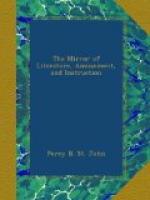“We infer, that the few of these people who yet survive have taken refuge in some sequestered spot, still in the northern part of the island, and where they can procure deer to subsist on.”
“On the 29th of November we had again returned to the mouth of the River Exploits, in thirty days after our departure from thence, after having made a complete circuit of about 200 miles in the Red Indian territory.”
“In conclusion, I congratulate the institution on the acquisition of several ingenious articles, the manufacture of the Boeothicks, or Red Indians, some of which we had the good fortune to discover on our recent excursion;—models of their canoes, bows and arrows, spears of different kinds, &c.; and also a complete dress worn by that people. Their mode of kindling fire is not only original, but, as far as we at present know, is peculiar to the tribe. These articles, together with a short vocabulary of their language, consisting of 200 or 300 words, which I have been enabled to collect, prove the Boeothicks to be a distinct tribe from any hitherto discovered in North America. One remarkable characteristic of their language, and in which it resembles those of Europe more than any other Indian languages do, with which we have had an opportunity of comparing it,—is its abounding in diphthongs.”
Mr. Cormack thinks that after the unfortunate circumstances attending past encounters between the Europeans and the Red Indians, it is best now to employ Indians belonging to the other tribes to be the medium of the intercourse in view; and he has chosen three intelligent men from Newfoundland to follow up the search.
* * * * *
NOTES OF A READER.
* * * * *
DERWENTWATER.
The following touching episodal extract is from Dr. Southey’s Colloquies on the Progress and Prospects of Society:—The best general view of Derwentwater is from the terrace, between Applethwaite and Milbeck, a little beyond the former hamlet. The old roofs and chimneys of that hamlet come finely in the foreground, and the trees upon the Ornathwaite estate give there a richness to the middle ground, which is wanting in other parts of the vale. From that spot I once saw three artists sketching it at the same time—William Westall (who has engraved it among his admirable views of Keswick,) Glover, and Edward Nash, my dear, kind-hearted friend and fellow-traveller, whose death has darkened some of the blithest recollections of my latter life. I know not from which of the surrounding heights it is seen to most advantage; any one will amply repay the labour of the ascent; and often as I have ascended them all, it has never been without a fresh delight. The best near view is from a field adjoining Friar’s Craig. There it is that, if I had Aladdin’s lamp, or Fortunatus’s purse (with leave of Greenwich Hospital be it spoken,) I would build myself a house.




